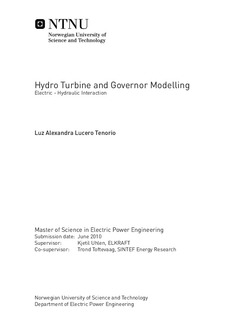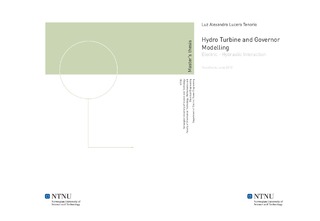| dc.contributor.advisor | Uhlen, Kjetil | nb_NO |
| dc.contributor.advisor | Toftevaag, Trond | nb_NO |
| dc.contributor.author | Lucero Tenorio, Luz Alexandra | nb_NO |
| dc.date.accessioned | 2014-12-19T13:52:18Z | |
| dc.date.available | 2014-12-19T13:52:18Z | |
| dc.date.created | 2010-10-11 | nb_NO |
| dc.date.issued | 2010 | nb_NO |
| dc.identifier | 356227 | nb_NO |
| dc.identifier | ntnudaim:5451 | nb_NO |
| dc.identifier.uri | http://hdl.handle.net/11250/256915 | |
| dc.description.abstract | This Master s Thesis work deals with the development of improved hydro turbine models for the evaluation of a hydraulic power generating system performance in response to small disturbances in power system analysis tool. These improved models must be able to reflect the possible interaction between the hydraulic system and power system in the computer simulations of a power plant equipped with Francis turbines.The accuracy of a Hydraulic Power Generating System is studied by means of analysis of the dynamic behaviour of different models of the hydraulic machine and conduit system. The stability study of different models for Synchronous Machines and Turbine Governing System are beyond the scope of this work.Appropriate representations of the hydraulic turbine and conduit system are developed in various models of varying degrees of detail. Firstly, nonlinear models for a simple turbine without surge tank considering the inelastic and elastic travelling wave effects have been developed. After that, nonlinear models considering the inelastic and elastic travelling wave effects for a turbine with surge tank for Hydropower Systems with long length penstocks are implemented. Finally, the nonlinear models for a turbine with long length penstocks are linearized at an operating point considering both the nonlinear turbine characteristics and the travelling wave effects.The Master s Thesis work is divided into three parts. The first part, comprising Chapters 2 to 8, reviews the physical characteristics and mathematical models of the components of a hydraulic power generating system. The influence of each component of the power system by means of appropriate mathematical models is essential for the understanding of system stability. The second part, comprising Chapters 9 to 11, deals with the dynamic study of the system stability characteristics of the different hydraulic power generating system models implemented in SIMPOW and LVTrans. Finally, the third part, Chapter 12 and Chapter 13, presents the discussion of the simulation results of the hydroelectric power system models, and draws general conclusions on this work and suggests possibilities for the approach further work, respectively.It was concluded that approaches based on nonlinear and linear models including the elasticity of the conduit system and the nonlinear turbine characteristics extracted from the Hill Charts, are the most accurate models for any acceptable study of the interaction between hydraulic system and power system.The study of dynamic performance and interaction between the hydraulic system and power system of these extended linear and nonlinear models including the elastic water hammer effect and varying the nonlinear characteristics of the hydraulic turbine must be studied in detail. | nb_NO |
| dc.language | eng | nb_NO |
| dc.publisher | Institutt for elkraftteknikk | nb_NO |
| dc.subject | ntnudaim:5451 | no_NO |
| dc.subject | MSELPOWER Master of Science in Electric Power Engineering | no_NO |
| dc.subject | Elektrisk Energiteknikk | no_NO |
| dc.title | Hydro Turbine and Governor Modelling: Electric - Hydraulic Interaction | nb_NO |
| dc.type | Master thesis | nb_NO |
| dc.source.pagenumber | 145 | nb_NO |
| dc.contributor.department | Norges teknisk-naturvitenskapelige universitet, Fakultet for informasjonsteknologi, matematikk og elektroteknikk, Institutt for elkraftteknikk | nb_NO |

